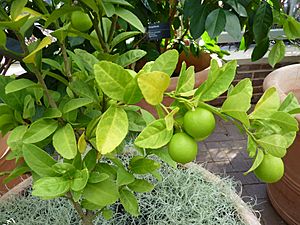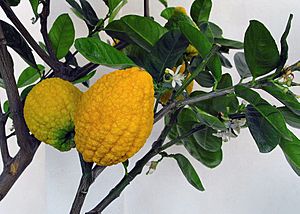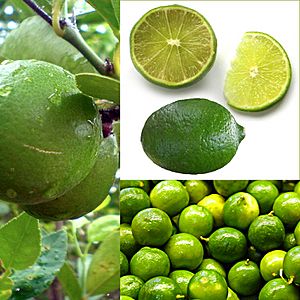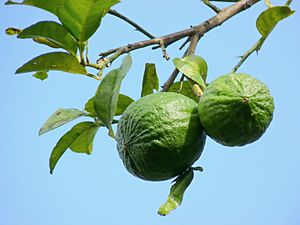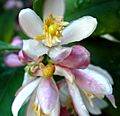Key lime facts for kids
Quick facts for kids Key Lime |
|
|---|---|
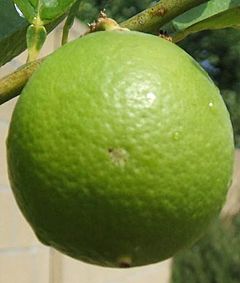 |
|
| Key Lime | |
| Scientific classification | |
| Kingdom: | |
| Division: | |
| Class: | |
| Order: | |
| Family: | |
| Genus: | |
| Species: |
C. aurantiifolia
|
| Binomial name | |
| Citrus aurantiifolia (Christm.) Swingle
|
|
The Key lime is a type of citrus fruit that is a mix of different citrus plants. Its fruit is round and usually about 1 to 2 inches (2.5 to 5 cm) wide. Key limes are often picked when they are still green, but they turn yellow when they are fully ripe.
Compared to the Persian lime, Key limes are smaller and have more seeds. They are also more sour, have a stronger smell, and a thinner skin. People really like Key limes because they have a special flavor that is different from other limes.
The name "Key lime" comes from the Florida Keys. This is where the fruit is famous for being the main ingredient in Key lime pie. It is also called West Indian lime, bartender’s lime, Omani lime, or Mexican lime. In the Philippines, some types are known as dayap and bilolo.
Contents
What's in a Name?
The English word lime comes from the Arabic word līma, which came from the Persian word limu. The "Key" part of the name comes from the Florida Keys. This is where the fruit grows naturally.
The Oxford English Dictionary first recorded the term "key lime" in 1905. It was in a magazine called Country Gentleman. The magazine said the fruit was "the finest on the market. It is aromatic, juicy, and much better than the lemon."
History of Key Limes
Key limes first grew in Southeast Asia. They likely traveled through the Middle East to North Africa. From there, they went to Sicily and Andalusia. Spanish explorers then brought them to the Caribbean, including the Florida Keys.
A person named Henry Perrine is known for bringing the Key lime to Florida. From the Caribbean, growing limes spread to warm areas of North America. This included Mexico, Florida, and later California.
Today, many Key limes sold in the US come from Mexico, Central America, and South America. They are also grown in Texas, Florida, and California. The Key lime has also led to the creation of several other types of limes.
What Key Limes Look Like
The Key lime tree is a bushy plant that can grow up to 16 feet (5 meters) tall. It has many thorns. There are also smaller types that can be grown indoors in colder places. The tree's trunk often has many branches that start low down.
The leaves are oval-shaped, similar to orange leaves. The flowers are yellowish-white with a bit of light purple on their edges. Key lime trees have flowers and fruit all year. However, they produce the most fruit from May to September in the Northern Hemisphere.
Sometimes, if the juice from a Key lime gets on your skin and then your skin is exposed to strong sunlight, it can cause a skin reaction. This reaction makes your skin extra sensitive to ultraviolet light.
Growing and Reproducing Key Limes
There are different ways to grow Key limes. You can grow this type of citrus from its seeds. The seeds need to stay wet until they are planted. If they dry out, they won't grow. If you are growing from seeds, they should be stored for at least 5 to 6 months before planting.
Another way to grow them is from cuttings or by air layering. This means taking a piece of the plant and helping it grow roots. This method can produce fruit within one year. It also creates new plants that are exactly like the parent plant. You can also dig around a grown tree to cut some roots. This will make new shoots grow that can be moved to a new spot.
Often, new Key lime plants are joined onto the roots of rough lemon or sour orange trees. This is called bud grafting. It helps the Key lime tree grow stronger roots.
The weather and when the fruit ripens are very important for growing lime trees. If it's always warm, you can plant potted trees any time of year. In cooler places, it's best to plant them in late winter or early spring. Key lime trees grow best in sunny spots with soil that drains well. They also need good air flow and protection from cold winds.
Harvesting Key Limes
How you grow Key limes greatly affects how many fruits you get and their quality. Trees grown from seeds take 4 to 8 years to start producing fruit. They produce the most fruit when they are about 10 years old. Trees grown from cuttings or air layering produce fruit much sooner. Sometimes they even produce fruit a year after planting. It takes about 9 months for the fruit to grow from a flower.
Key limes are picked when they have grown to the right size and start to turn yellow. To get the best quality fruit for selling, it's important not to pick them too early in the morning. Handling the fruit too early can release oils from the skin, which might cause them to spoil.
Keeping Key limes fresh after picking is important for selling them. Limes continue to ripen for a long time after they are harvested. Special methods are used to control how long they stay fresh. These include using plant hormones, fruit wax, and special cooling. However, even with these methods, a lot of fruit can still be lost after harvesting.
In India, most Key lime growers are small farmers. They often don't have access to fancy equipment for keeping fruit fresh. But simple methods can still help. One successful method is coating the limes with coconut oil. This helps them stay fresh longer, which means there's a steady supply of Key limes for the market. Key limes can also be made into black limes by boiling them in salty water and then drying them. Black lime is a spice often used in the Middle East.
Images for kids
-
A tree full of key limes in West Bengal, India.
-
Key lime fruits with persistent styles
See also
 In Spanish: Citrus × aurantiifolia para niños
In Spanish: Citrus × aurantiifolia para niños


